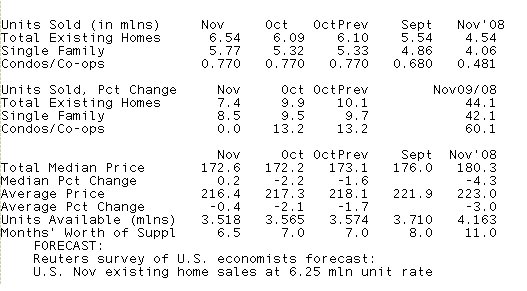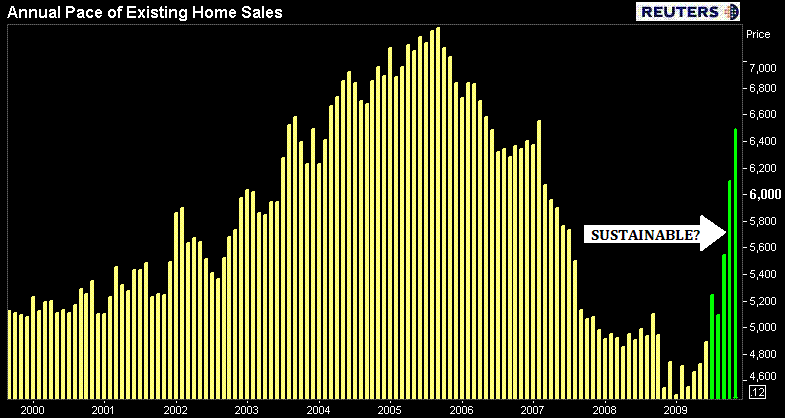The National Association of Realtors released Existing Home Sales data this morning.
READ HOW THE NAR COMPILES DATA AND GAIN A BETTER UNDERSTANDING OF SEASONAL INFLUENCES
When new homes are being built AND selling, money moves around the economy more efficiently. The size of the housing market combined with the broad influences it has over the economy make the real estate sector a reliable leading indicator of economic activity. Real estate is one of the first sectors to contract when a recession is looming and one of the first to show signs of recovery when economic activity begins to improve.
BUT...
When viewing housing data in the context of the broader economy, Existing Home Sales are not as forward looking as other housing indicators such as housing starts and building permits. This is for a few reasons...
Think about the materials that go into BUILDING a home....WOOD, STEEL, PLASTICS, WIRING, PIPING, CONCRETE, GLASS, ELECTRICITY, FURNITURE, CARPETING, ELECTRONICS, APPLIANCES....LABOR.
These goods and services are not a part of the money transfer process of an Exisiting Home Sale. Exisiting Homes are already built, and while there are more and more " foreclosure fixer uppers" on the market, the overall economic activity boost seen from a spike in new construction is absent from the Existing Home Sales spending supply chain.
Also, existing home sales data is only reported at the time of closing, when the deed is actually transferred to the new owner. It can take up to three months for a purchase transaction to close, if it closes at all as the origination process remains cluttered with roadblocks and delays. On top of this, the additional tighetening of credit guidelines is expected to continue to reduce the number of qualified borrowers who are looking to buy.
With that in mind. Read on...
In last month's report, existing-home sales surged 10.1 percent to an annual rate of 6.10 million units in October from a downwardly revised pace of 5.54 million in September. Sales activity is at the highest pace since February 2007 when it hit 6.55 million. Total housing inventory at the end of October fell 3.7 percent to 3.57 million existing homes available for sale, which represents a 7.0-month supply at the current sales pace, less than the revised for the worse 8.0-month supply which was reported in September. The national median existing-home price for all housing types was $173,100 in October, down 7.1 percent from October 2008.
In November, the NAR reports that sales of previously owned homes rose 7.4% to an annual rate of 6.54 million sales. Single family homes led the overall index higher, recording an uptick from 5.32 million sales to 5.77 million annual sales. While single family unit sales were up 8.5%, Condo sales were unchanged from last month's print. Also, both metrics improved at a slower pace than the October/September month over month gains (see table below).
The supply of previously owned homes fell from 3.565 million to 3.518 million, which works out to 6.5 months of supply at the current annual pace of existing home sales. Raw unsold inventory figures are 15.5 percent below levels one year ago. The last time there was a lower supply of homes on the market was April 2006 when it was at a 6.1-month supply.
WHOOO HOOO...."yeh buts" to follow below.

The headline from the NAR read "Another Big Gain in Existing-Home Sales as Buyers Respond to Tax Credit"
The opening line of the release: "Existing-home sales rose again in November as first-time buyers rushed to close sales before the original November 30 deadline for the recently extended and expanded tax credit, according to the National Association of Realtors®."
Lawrence Yun, NAR chief economist, said the rise was expected: “This clearly is a rush of first-time buyers not wanting to miss out on the tax credit, but there are many more potential buyers who can enter the market in the months ahead”.
Then he added a caveat: “We expect a temporary sales drop while buying activity ramps up for another surge in the spring when buyers take advantage of the expanded tax credit, which hopefully will take us into a self-sustaining market in the second half of 2010. In all, 4.4 million households are expected to claim the tax credit before it expires and balance should be restored to the housing sector with inventories continuing to decline.”
Don't miss the use of the word HOPEFULLY in there by the way. And then we got some good news on housing prices.
NAR President Vicki Cox Golder, owner of Vicki L. Cox & Associates in Tucson, Ariz., said conditions are optimal for buyers in the current market: “Inventories have steadily declined and are closer to balanced levels, which indicate home prices in many areas are either stabilizing or could soon stabilize and return to normal appreciation patterns,”
WOOOO HOOOO again...and now for the "YEH BUT"!
“This means buyers still have good choices but are purchasing near the bottom of the price cycle with historically low mortgage interest rates. Throw a tax credit on top and it really doesn’t get any better for buyers with secure jobs and long-term ownership plans.”
Although this is not really a huge revelation to most market watchers, it again calls attention to the long list of caveats attached to most economic outlooks and activity forecasts...including the Fed's. (SEE FOMC STATEMENT).
Buyers must have jobs! I suppose I could make it clearer.
According to the US Census Bureau and the BLS: 17.2% of Americans are underemployed or unemployed. Out of 153.9 million people in the labor force...26.5 million are unemployed or underemployed. (U6)
Plain and Simple: NO JOB= NO INCOME = BAD DTI = NO MORTGAGE.
This was fastest sales pace of previously owned homes since February 2007! I suppose progress is being made in the housing market. We have to start somewhere right?
JOBS JOBS JOBS!
Until jobs are being created (in droves) for the herd of citizens on unemployment benefits, the housing market will undergo a slow, frustrating recovery process, for mortgage and real estate professionals especially. The industry is not done contracting, profit margins will continue to shrink and more jobs will be lost as new regulations take effect and main stream lenders increase competitiveness within the mortgage sector. Stay cost efficient, stay nimble...
Once the economy does gain traction and growth resumes, willing and able unemployed folks will play a major role in the US recovery.
If you dont have a job, find a way to make yourself a more attractive labor source. Technology is replacing human brawn. More and more computers are performing production responsibilities humans once held. Costs are being cut and operations are becoming more productive with their resources. While this will eventually lead to more hiring in the future, job creation will be focused on specific intellectual capabilities. Human labor must be able to manage new technology.
The point: If you are without a job, dont waste this "time off". Go back to school. Re-educate and re-tool. Get new certifications and licenses. Find a way to evolve your intellectual capabilities. The labor market will be very competitive for years to come.
But yeh...wooo hooo for the first time home buyer tax credit led improvements off of record low levels of sales activity!!!!








